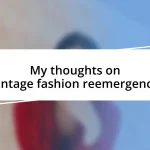Key takeaways:
- DIY fashion fails highlight the gap between vision and execution, underscoring the importance of patience and emotional investment in creative projects.
- Common mistakes in DIY fashion include incorrect measurements, poor fabric choice, and rushing the sewing process, all of which emphasize the need for planning and precision.
- Transforming failures into successes can foster creativity and collaboration, as sharing experiences with others often leads to innovative ideas and deeper connections.

DIY fashion fail definitions
DIY fashion fails can be defined as attempts to create or modify clothing that don’t turn out as intended, often leading to humorous or cringe-worthy results. I remember when I tried to resize an oversized shirt by simply cutting it down the sides — only to realize I had turned it into a bizarre crop top that left little to the imagination! Has that ever happened to you?
At times, these fails stem from a disconnect between our vision and the execution, highlighting the gap between inspiration and reality. I once set out to replicate a stunning dress I saw online, but the end product resembled more of a potato sack than the chic design I imagined. It’s moments like these that remind us that not every DIY project will match our expectations, and that’s totally okay.
Another layer to consider is the emotional investment in these projects. When we pour our heart and creativity into something, the stakes feel high. Have you experienced that sinking feeling when your piece just doesn’t come together? That emotional connection shows how much we care, making the learning process all the more valuable, despite the occasional hilarity of our outcomes.

Common mistakes in DIY fashion
One common mistake in DIY fashion is underestimating the importance of measurements. I vividly remember an attempt to create a pleated skirt, where I thought winging it with fabric leftovers would be sufficient. I didn’t take my waist measurement, and ended up with something that could barely fit a doll! Precision is key here, and it’s a lesson I learned the hard way.
Another prevalent error is neglecting the fabric choice. I was excited to use some lovely lace for a top once, but I didn’t consider how delicate it was for the type of design I wanted. The final product was not only see-through but also frayed at the edges after one wash! Selecting the right material is crucial because it can make or break your creation in ways you might not immediately see.
Lastly, I often see DIYers rushing through the sewing process. I once hastily stitched a pair of pants without pinning anything first, thinking I could fix it on the fly. Well, they turned out completely lopsided! Taking your time and properly securing your pieces will save you from these “lopsided” surprises.
| Common Mistakes | Examples |
|---|---|
| Incorrect Measurements | Failing to measure leads to ill-fitting garments, like my doll-sized skirt. |
| Wrong Fabric Choice | Using lace for a structured top resulted in a frayed, see-through piece. |
| Rushing the Process | Hastily sewn pants without pins ended up lopsided. |

Lessons learned from DIY fails
One of the most significant lessons I’ve learned from DIY fashion fails is the value of patience. I recall being so eager to recreate a stylish off-the-shoulder top that I rushed through the cutting phase. In my haste, I didn’t account for the fabric’s stretch, and what resulted was less of a top and more of a fashion nightmare that barely stayed on my shoulders. It’s a gentle reminder that good things take time, and there’s no substitute for a thorough, thoughtful approach.
Here are a few key lessons that stand out from my experiences:
- Embrace imperfection: Sometimes, a mistake can lead to an unexpected twist, like turning a failed dress into a funky bag.
- Experiment freely: Even abysmal outcomes can spark creativity for future projects; inspiration often arises from the most unlikely places.
- Document your process: Keeping notes or even a photo log helps avoid the same mistakes in future projects and tracks your progress over time.
- Ask for feedback: Sharing your work (and its flaws) with friends can provide fresh perspectives and sometimes even hilarious suggestions for improvement!

Tips for successful DIY projects
When diving into a DIY project, I can’t stress enough the importance of having a clear plan. I once embarked on an ambitious project to craft a tailored jacket without sketching out my design first. It felt exhilarating in the moment, but I soon found myself swimming in confusion as multiple ideas clashed. Trust me; taking a few moments to outline your vision can save you countless hours of reworking!
Preparing your workspace is another crucial tip. I remember a time I rushed to start sewing and didn’t clear my table of clutter. The chaos led to losing track of my tools, and more importantly, I ended up misplacing a vital pattern piece. Creating a clean and organized area not only boosts creativity but helps you stay focused—yes, a little tidiness can go a long way!
Lastly, I’ve learned that having the right tools is non-negotiable. I once attempted a fabric paint project without the proper brushes, thinking I could just make do with what I had on hand. The result? A splotchy, unrecognizable print that made me cringe. Investing in or borrowing the correct tools can elevate your DIY game immensely; they truly make all the difference in achieving the vision you see in your mind’s eye.

Transforming failures into successes
Transforming failures into successes is all about shifting your perspective. I vividly remember a time when I tried to upcycle an old shirt into a chic crop top. Instead, I ended up with a piece that looked more like a quirky oven mitt. But instead of sulking, I took a step back and marveled at my unintentional creativity; I flipped it into a unique tote bag that caught quite a few eyes! Isn’t it funny how a “failure” can sometimes lead to the most interesting creations?
I think transformation thrives on experimentation. I once decided to add a tie-dye effect to a pair of jeans, and let’s just say the results were far from what I envisioned—more like a disaster than a trend. However, that incident ignited a series of thought-provoking ideas. It encouraged me to explore a bolder color palette. What if I hadn’t dared to be different? I came to realize that every stumble can be a stepping stone, leading to unexpected avenues of self-expression.
Sharing my fashion misadventures with friends has also been incredibly enriching. One time, I proudly showcased an embellished jacket I worked on, only for my friend to suggest adding sequins in a completely different pattern. At first, I was taken aback! But using her suggestions, I revamped my piece and turned it into a stunning showstopper. It reinforced the idea that collaboration—yes, even in our failures—can blossom into triumphs. Have you ever considered how a fresh pair of eyes could change your entire project?

Sharing your DIY fashion journey
Sharing your DIY fashion journey can be one of the most fulfilling aspects of the whole process. I remember the first time I posted one of my DIY projects on social media. I was a mix of excitement and anxiety—would people love it? Critique it? When I finally hit ‘share,’ the overwhelming support and encouragement from my friends and followers reminded me just how important it is to put yourself out there. Have you ever felt that rush of validation when someone appreciates your creative efforts?
Engaging with others about my DIY fails has turned out to be a real conversation starter. There was this one time I made a pair of oversized shorts, thinking they would be trendy, only to realize they looked like I borrowed them from a football player! Instead of hiding this fashion blunder, I opted to share it with my community. To my surprise, many chimed in with their own similar mishaps, creating a sense of camaraderie that made me feel less alone. Isn’t it amazing how our struggles can connect us?
Opening up about my DIY journey has also inspired me to embrace vulnerability in fashion. I vividly recall when I wore a dress that I had painstakingly altered. It had quirks that only I knew about, yet that led to an incredible conversation at a party. People weren’t just drawn to the aesthetic; they wanted the backstory, the ‘how’ behind it. This taught me that sharing the journey—even the wobbly parts—can create deeper connections and turn a simple outfit into a conversation piece. Why not share your unique story and see how it unfolds?














